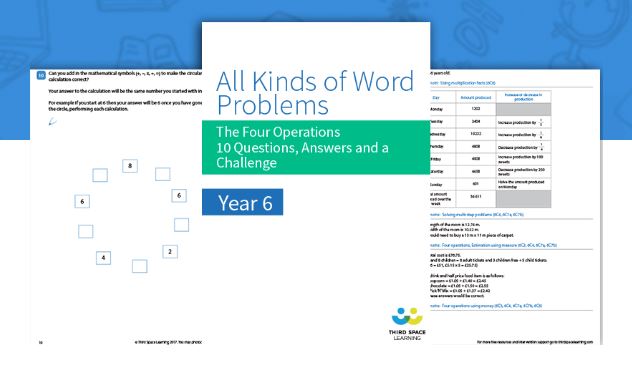24 Ratio Word Problems for Year 6 to Year 8 With Tips On Supporting Pupils’ Progress
Ratio word problems are introduced for the first time in upper Key Stage 2. The earliest mention of ‘Ratio’ in the National Curriculum is in the Year 6 programme of study, where a whole section is dedicated to Ratio and Proportion.
At this early stage, it is essential to concentrate on the language and vocabulary of ratio. Children need to be clear on the meaning of the ratio symbol right from the start of the topic. Word problems really help children understand this concept, as they make it much more relevant and meaningful than a ratio question with no context.
- Ratio word problems in the National Curriculum
- Why are word problems important for children’s understanding of ratio?
- How to teach ratio word problem solving in Year 6 and early secondary school
- Ratio word problems for year 6
- Ratio word problems for year 7
- Ratio word problems for year 8
- More word problems
Concrete resources and pictorial representations are key to the success of children’s early understanding of ratio. These resources are often used in word problems for year 3, word problems for year 4 and word problems for year 5. There is often a misconception amongst upper Key Stage 2 teachers and students, that mathematical equipment is only for children who struggle in maths. However, all students should be introduced to this new concept through resources, such as two-sided counters and visual representations, such as bar models as this can help with understanding basic mathematical concepts such as addition and subtraction word problems.
All Kinds of Word Problems Four Operations
Download this free pack of mixed word problems covering all four operations. Test your student's problem solving skills over a range of topics.
Download Free Now!As pupils progress into Key Stage 3, they continue to build on their knowledge and understanding of ratio. As students move away from the practical and visual resources, word problems continue to be a key element to any lessons involving ratio. As students move into Key Stage 4, they continue to build on this knowledge of ratio and can expect to encounter ratio and proportion word problems in their GCSE maths exams.
Ratio word problems are an essential component of any lessons on ratio, to help children understand how ratio is used in real-life. To help you with this, we have put together a collection of 24 word problems including multi-step word problems, which can be used by pupils from Year 6 to Year 8.
Ratio word problems in the National Curriculum
Ratio in KS2
Children are first introduced to ratio and ratio problems in Year 6. The National Curriculum expectations for ratio are that students will be able to:
- solve problems involving the relative sizes of 2 quantities where missing values can be found by using integer multiplication and division facts
- solve problems involving the calculation of percentages [for example, of measures and such as 15% of 360] and the use of percentages for comparison
- solve problems involving similar shapes where the scale factor is known or can be found
- solve problems involving unequal sharing and grouping using knowledge of fractions and multiples.
Ratio in KS3
Students in Key Stage 3 continue to build on their knowledge of ratio from primary. The expectations for Years 7 and 8 are that pupils will:
- Use scale factors, scale diagrams and maps
- Express one quantity as a fraction of another, where the fraction is less than 1 and greater than 1
- Use ratio notation, including reduction to simplest form
- Divide a given quantity into two parts in a given part:part or part:whole ratio; express the division of a quantity into two parts as a ratio
- Understand that a multiplicative relationship between two quantities can be expressed as a ratio or a fraction.
- Relate the language of ratios and the associated calculations to the arithmetic of fractions and to linear functions.
- Solve problems involving percentage change, including: percentage increase, decrease and original value problems and simple interest in financial mathematics.
Why are word problems important for children’s understanding of ratio?
Solving word problems are important for helping children to develop their understanding of ratio and the different ways ratio is used in everyday life. Without this context, ratio can be quite an abstract concept, which children find difficult to understand. Word problems bring ratio to life and enable students to see how they will make use of this skill outside the classroom.
Third Space Learning’s online one-to-one tuition programme relates maths concepts to real life situations to deepen conceptual understanding. Personalised fill the gaps in each individual student’s maths knowledge, our programmes help to build skills and confidence.

How to teach ratio word problem solving in Year 6 and early secondary school
It is important children learn the skills needed to solve ratio word problems. As with any maths problem, children need to make sure they have read the questions carefully and thought about exactly what is being asked and whether they have fully understood this. The next step is to identify what they will need to do to solve the problem and whether there are any concrete resources or pictorial representations which will help them. Even older pupils can benefit from drawing a quick sketch to understand what a problem is asking.
Here is an example:
Jamie has a bag of red and yellow sweets.
For every red sweet there are 2 yellow sweets.
If the bag has 6 red sweets. How many sweets are in the whole bag?
How to solve:
What do you already know?
- We know that for every red sweet there are 2 yellow sweets.
- If there are 6 red sweets, we need to work out how many yellow sweets there must be.
- If there are 2 yellow sweets for each 1 red sweet, then we must need to multiply 2 by 6, to work out how many yellow sweets there are with 6 red sweets.
- Once we have worked out the total number of yellow sweets (12), we then need to add this to the 6 red sweets, to work out how many sweets are in the bag altogether.
- If there are 6 red sweets and 12 yellow sweets, there must be 18 sweets in the bag altogether.
How can this be represented pictorially?
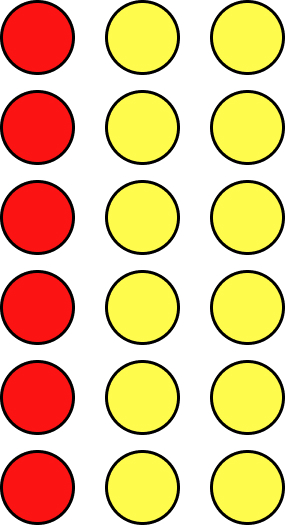
- We can use the two-sided counters to represent the red and yellow sweets.
- If we put down 1 red counter and 2 yellow counters.
- We then need to repeat this 6 times, until there are 6 red counters and 12 yellow counters.
- We can now visually see the answer to the word problem and that there are now a total of 18 counters (18 sweets in the bag).
Ratio word problems for year 6
Word problems for year 6 often incorporate multiple skills: a ratio word problem may also include elements from multiplication word problems, division word problems, percentage word problems and fraction word problems.
Question 1
Sophie was trying to calculate the number of students in her school.
She found the ratio of boys to girls across the school was 3:2
If there were 120 boys in the school
- How many girls were there?
- How many students were there altogether?
Answer: a) 80 b) 200
- 80 girls
This can be shown as a bar model.
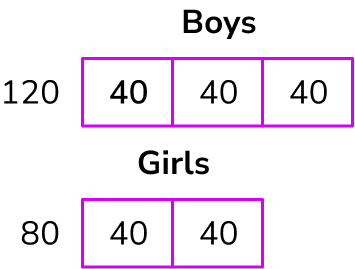
120 ÷ 3 = 40
40 x 2 = 80
- 200 students altogether
120 boys + 80 girls = 200
Question 2
Pupils on the Eco Committee in Year 6 wanted to investigate how many worksheets were being printed each week.
They found that there were 160 maths worksheets and 80 English worksheets
What is the ratio of maths to English worksheets?
Answer: 2:1
Ratio of 160:80
This can be simplified to 2:1 by dividing both 160 and 80 by 80
Question 3
The Year 6 football club has 30 members. The ratio of boys to girls is 4:1. How many boys and girls are in the club?
Answer: 24 boys and 6 girls
The ratio of 4:1 has 5 parts
30 ÷ 5 = 6
Boys: 4 x 6 = 24
Girls 1 x 6 = 6
Question 4
Yasmine has a necklace with purple and blue beads.
The ratio of purple:blue beads = 1:3
There are 24 beads on the necklace. How many purple and blue beads are there?
Answer: 6 purple beads and 18 blue beads
The ratio of 1:3 has 4 parts
24 ÷ 4 = 6 beads per part
Purple: 1 x 6 = 6
Blue 3 x 6 = 18
Question 5
Maisie drives past a field of sheep and cows.
She works out that the ratio of sheep to cows is 3:1
If there are 5 cows in the field, how many sheep are there?
Answer: 15 sheep
If there are 5 cows in the field, the 1 has been multiplied by 5.
We need to also multiply the 3 by 5, which is 15
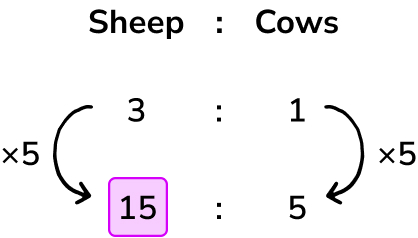
Question 6
At a party there is a choice of 3 flavours of jelly – orange, blackcurrant and lemon,
The ratio of the jellies are 3:2:1 (orange: blackcurrant: lemon)
If there are 9 orange jellies. How many blackcurrant and lemon jellies are there?
Answer: 6 blackcurrant and 3 lemon jellies
To get 9 jellies, we need to multiply 3 by 3. This means we need to multiply 2 x 3 = 6 and 1 x 3 = 3
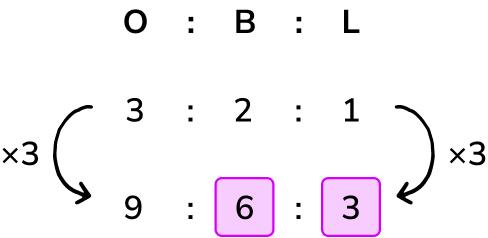
Question 7
The school photocopier prints out 150 sheets in 3 minutes.
How many sheets can it print out in 15 minutes?
Answer: 750 sheets in 15 minutes
We need to multiply 3 by 5 to get 15 minutes. This means we also need to multiply 150 by 5 = 750
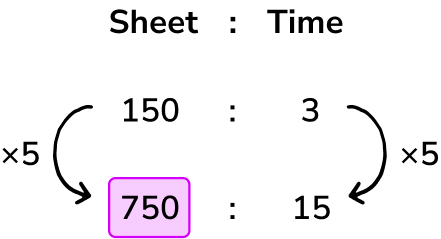
Question 8
Mason carried out a survey of the favourite sports of children in Year 6.
For every 3 students who chose football, 2 chose swimming and 1 chose basketball.
12 children chose football. How many took part in the survey altogether?
Answer: 24 children took part in the survey.
If we multiply 3 by 4, we get to the 12 students who chose football.
We need to also multiply the 2 by 4 (8 children chose swimming) and the 1 by 4 (4 children chose swimming)
12 + 8 + 4 = 24
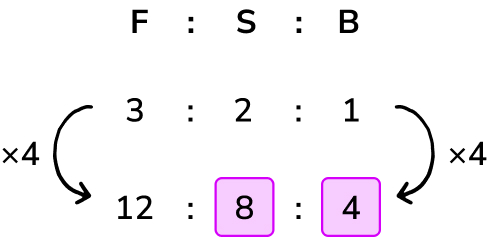
Ratio word problems for year 7
Question 1
David has 2 grandchildren: Maisie (age 6) and Lottie (age 3)
He decides to share £60 between the 2 children in a ratio of their ages.
How much does each child get?
Answer: Maisie gets £40, Lottie gets £20
Ratio of 2:1 = 3 parts
60 ÷ 3 = £20 per part
Maisie: 2 x 20 = £40
Lottie: 1 x 20 = £20
Question 2
A rectangle has the ratio of width to length 2:3. If the perimeter of the rectangle is 50cm, what’s the area?
Answer: Area: 150cm^{2}
Width: 10cm
Length: 15cm
Divide 50 by 5 to work out 1 part = 10
The 2 widths must by 2 x 10 = 20
The 2 lengths must be 3 x 10 = 30
To work out the width of 1 side, divide the 20 by 2 = 10
To work out the length of 1 side, divide the 30 by 2 = 15
Area: 10 x 15 = 150cm2
Question 3
In Bethany’s class there are 20 girls and 12 boys.
Write down the ratio of girls to boys in the simplest form
Answer: 5:3
20:12
(Divide both sides by 4 = 5:3)
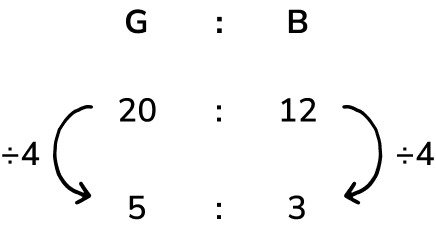
Question 4
A piece of ribbon is 45cm long.
It has been cut into 3 smaller pieces in a ratio of 4:3:2
How long is each piece?
Answer: 20cm, 15cm and 10cm
4:3:2 =9 parts: 45 ÷ 9 = 5cm per part
4 x 5 = 20cm
3 x 5 = 15cm
2 x 5 = 10cm
Question 5
Chloe is making a smoothie for her and her 3 friends.
She has the recipe for making a smoothie for 4 people: 240ml yoghurt, 120 ml milk, 300ml apple juice, 180g strawberries and 1 table spoon of sugar.
- How much yoghurt would be needed to make a smoothie for 8 people.
- How many g of strawberries are needed to make the smoothie for 2 people?
Answer:
- 480 ml yoghurt
240ml x 2 = 480
- 90g strawberries
180 ÷ 2 = 90
Question 6
The ratio of cups of flour:cups of water in the recipe for making the dough for a pizza base is 7:4.
The pizza restaurant needs to make a large quantity of pizzas and is using 42 cups of flour. How much water will be needed?
Answer: 24 cups of water
Multiply 7 by 6 to get 42 cups of flour.
We therefore need to also multiply the 4 by 6 to work out how many cups of water are needed.
4 x 6 = 24
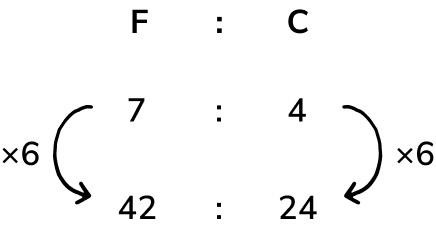
Question 7
Ahmed shared £56 between him and Hamza in a ratio of 3:5 (3 for Hamza and 5 for him).
How much did each get?
Answer: Ahmed got £35, his brother got £21
Ratio of 3:5 = 8 parts
56 ÷ 8 = £7 per part
3 x 7 =£ 21
5 x 7 = £35
Question 8
Amber and Holly share some money in a ratio of 5:7
If Amber gets £30. How much do they have between them to share?
Answer: £72
Amber gets £30 which is 5 parts: 30 ÷ 5 = 6
Holly gets 7 x 6 = £42
£30 + £42 = £72
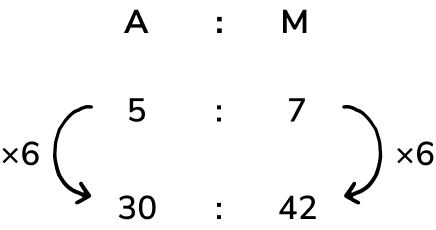
Ratio word problems for year 8
Question 1
Two companies are making an orange coloured paint.
Company A makes the orange paint by mixing red and yellow paint in a ratio of 5:7
Company B makes the orange paint by mixing red and yellow paint in a ratio of 3:4.
Which company uses a higher proportion of red paint to make the orange?
Answer: Company B uses more red paint.
Company A: 5:7 = \frac{5}{12} is red
Company B: 3:4 = \frac{3}{7} is red
We can compare the fractions by giving them the same denominator, to find the equivalent fractions.
\frac{5}{12}=\frac{35}{84} \frac{3}{7}=\frac{36}{84}Question 2
Students in a school have to choose one Humanities subject – History or Geography.
The ratio of boys to girls is 5:4 and \frac{3}{5} of the girls study History.
There are 225 students in the year. How many girls study History?
Answer: 60 girls study History
The ratio of 5:4 has 9 parts. Divide 225 by 9 to work out 1 part = 25
There are 5 x 25 boys = 125 and 4 x 24 girls = 100
\frac{3}{5} of 100 = 60
Question 3
The angles in a triangle are in the ratio of 3:4:5 for angles A, B and C
Calculate the size of each angle.
Answer:
Angle A: 45°
Angle B: 60°
Angle C: 75°
3:4:5 = 12 parts. 180 ÷ 12 = 15 (each part is worth 15°)
3 x 15 = 45
4 x 15 = 60
5 x 15 = 75
Question 4
The audience in a theatre has a ratio of 2:1 adults to children.
There are 2,250 people in the audience.
The cost of an adult ticket is £10 and a child ticket is £5
How much money did the theatre make from the ticket sales
Answer: £18,750
Ratio of 2:1 = 3 parts
2250 ÷ 3 = 750 people per part
Number of adults: 2 x 750 = 1500 Number of children: 1 x 750 = 750
Cost of adult tickets = 1500 x £10 = £15,000 Cost of child tickets = 750 x £5 = £3,750
Total cost: £15,000 + £3,750 = £18,750
Question 5
Sophia and Jessica collect stickers and stamps.
Altogether they have the same number of stickers as stamps.
The ratio of stickers Sophia has to the stickers Jessica has is 3:7.
The ratio of stamps Sophia has to stamps Jessica has is 1:4
Show Jessica has more stamps than stickers.
Answer:
Ratio of stickers to stickers has 10 parts
Ratio of stamps to stamps has 5 parts.
To make the stamps equivalent to the stickers, they need to be doubled – 1:4 becomes 2:8, compared to 3:7 stickers, therefore, Jessica has more stamps than stickers.
Question 6
A drink is made by mixing pineapple and lemonade in the ratio of 1:4.
Pineapple costs £1.50 per litre. Lemonade costs £1.30 per litre (Bottles are sold in 1 litre containers)
How much will it cost to make 4 litres of drink?
Answer: £6.70
Ratio of pineapple to lemonade has 5 parts
4l of drink = 4000 ml. 1 part = 4000 ÷ 5 = 800
Pineapple = 1 x 800 = 800ml
Lemonade = 4 x 800 = 3200ml
1 Bottle of pineapple will be needed (£1.50) and 4 bottles of lemonade (4 x £1.30 = £5.20)
Total cost = £1.50 + £5.20 = £6.70
Question 7
The ratio of Amber’s age to Zymal’s age is 5:7
If Zymal is 12 years older than Amber, how old are both Amber and Zymal
Answer: Amber: 30 years & Zymal: 42 years
Zymal is 12 years older. This means that the 2 parts more in the ratio of 5:7 must be worth 12 years. Therefore, 1 part = 6 years.
Amber is 5 x 6 = 30 years
Zymal is 7 x 6 = 42 years
Question 8
Hamza, Jude and Adam are collecting red and yellow leaves for an art project.
In total they collect the same number of red and yellow leaves.
The 3 boys collect red leaves in a ratio of 4:7:9 and yellow leaves in a ratio of 3:1:5 (Hamza:Jude:Adam)
Did Hamza collect more red leaves or yellow leaves?
Answer: Hamza collected more yellow leaves (60 yellow, compared to 36 red)
Red leaves have a ratio of 20 parts, yellow leaves have a ratio of 9 parts. To make them both equivalent, they both need to have 180 parts (20 x 9 = 180) and (9 x 20 = 180)
4:7:9 = 20 parts red leaves. Multiply each part by 9 36:63:81
3:1:5= 9 parts yellow leaves. Multiply each part by 20 = 60:20:100
Hamza collected more yellow leaves (60 yellow leaves and 36 red leaves)
More word problems
Looking for word problems on more topics? Take a look at our practice problems for Years 3-6 including money word problems, time word problems, addition word problems and subtraction word problems.
DO YOU HAVE STUDENTS WHO NEED MORE SUPPORT IN MATHS?
Every week Third Space Learning’s specialist primary maths tutors support thousands of students across hundreds of schools with weekly online 1 to 1 maths lessons designed to plug gaps and boost progress.
Since 2013 these personalised one to one lessons have helped over 150,000 primary and secondary students become more confident, able mathematicians.
Learn how tutors develop pupils’ maths fluency or request a personalised quote for your school to speak to us about your school’s needs and how we can help.

